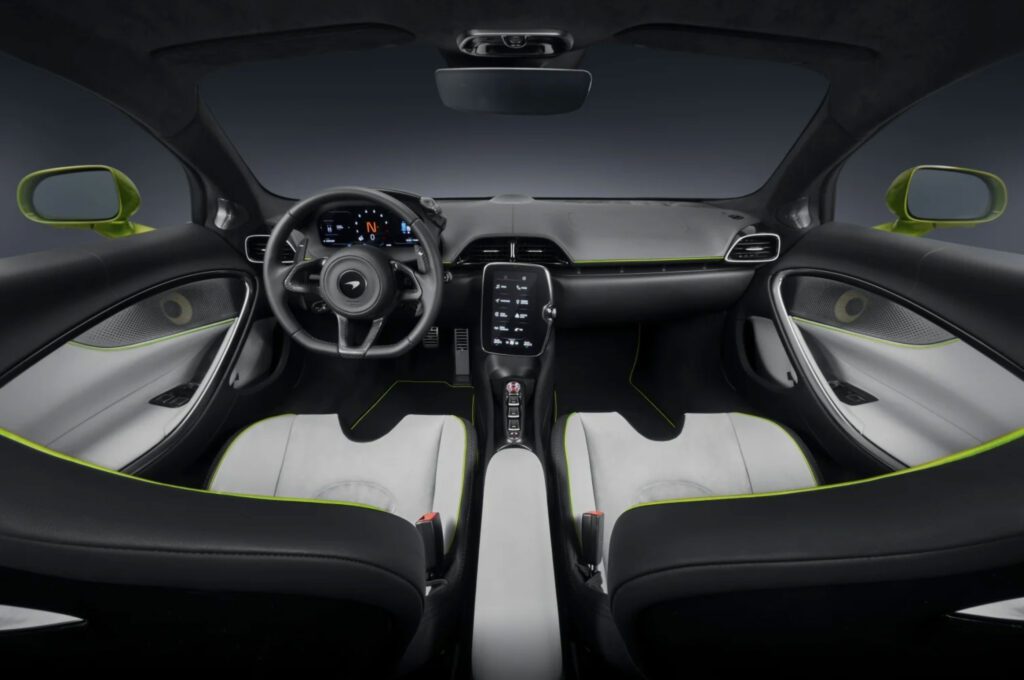McLaren Artura

McLaren brings its “E” game.
FAITHFUL READERS KNOW THAT I HAVE A SPECIAL PLACE IN MY HEART for McLaren. I have driven most of their offerings and have enjoyed them all. There’s something that is unmistakable about the McLaren DNA — regardless of what’s on paper, the cars feel faster. No doubt it’s because of (or at least mostly due to) the famous McLaren suspension, which really involves the driver in the entire experience. Whatever the reason, that experience is both engaging and delightful.
The Artura is the first of McLaren’s Supercar series to utilize hybrid power. Like McLaren’s Ultimate series P1 and Speedtail, the Artura combines a gasoline-powered motor (a twin-turbo V-6) with the immediacy of an electric motor for a combined 671 horsepower and 531 pound-feet of torque. As one might expect with those metrics, the Artura can sprint from zero to 60 in three seconds flat and run up to a top speed of 205 miles per hour.
McLaren’s claim to fame always has been lightness, and the Artura glides gracefully into that group with a 3,000-pound dry weight. With a lighter and stiffer aluminum frame than its predecessors and a carbon-fiber tub comprised of some 500 pieces, the Artura also features an entirely new electrical ethernetbased architecture that weighs less and provides far quicker data transmission rates than were enjoyed by previous models. The lightness and efficient electrical transfer also allow for an electricity fuel-efficiency rating of 39 mpg-e — even if the Artura runs in all-electric mode on a racetrack, there is no loss of performance. No wonder McLaren boasts that the Artura has 90% of the power available to the driver within two-tenths of a second! The Artura also provides an 80% battery charge in only 2.5 hours.
McLaren’s new eight-speed transmission is more compact than ever, which allows the Artura to have a shorter wheelbase, thereby increasing the car’s agility. The transmission size is helped by the fact that there is no reverse gear — the Artura utilizes the electric motor for backing up.
The design is fresh but still true to the McLaren DNA. The “S” swoosh of the headlights, the high dual exhausts above the bumper, the ground effects visible from the rear, and, of course, the scream of the engine at high rev all tell the world that there’s a McLaren in their midst.
While experiencing an Artura at standstill is a joy, driving an Artura takes the pleasure to a much higher level. The car sits low, so entrance and egress require the right step-and-bend-and-slide that I mastered pretty quickly — of course, I have driven most of the McLarens, so I really felt at home right away. (I measure the ability to enter a supercar using the calculation of the size of the door opening times the driver’s age, agility, girth, and practice, divided by the pride of getting in (and out) in front of other people.) The controls fall easily to hand, and all the important switches, buttons, and levers are where one would expect. And leave it to McLaren to have a two-way paddle shifter, which allows the driver to pull back on the left paddle to downshift or push forward on the right lever to accomplish the same. Upshifts work with the same alternatives — pull back on the right or push forward with the left. That choice comes in handy when, for example, you’re about to reach for your mocha frappa cuppa on your morning commute.
Everywhere I went with the Artura, it drew a crowd. While perhaps not as radical a design as some of its stablemates (I’m looking at you, Senna and Speedtail), it’s stunning in person, and the wild colors that McLaren makes available help with that sizzle and flash. “Mine” was a beautiful Paris Blue, a stunning medium color that looked great with the black wheels and yellow brake calipers. The black interior with red piping was a perfect complement to the looks. Onlookers’ smiles grew as I fired up the car, as the exhaust is loud but not harsh, which allowed the crowd to appreciate the sound without needing to cover their ears.
To paraphrase Mark Twain, I’ve never met a McLaren that I didn’t like. McLaren, long a well-known race car brand that had produced one of the fastest production cars ever (the F1, constructed from 1993 to 1998), seriously entered the production road-car world with the MP4-12C in 2009. In the years since,their Supercar, GT, and Ultimate series of cars have gotten better and better. The Artura is a testament to that achievement and proves that McLaren can segue into the gas/electric world with all of the high-tech wizardry and driving enjoyment for which the company has been known since the beginning.



Sorry, the comment form is closed at this time.